

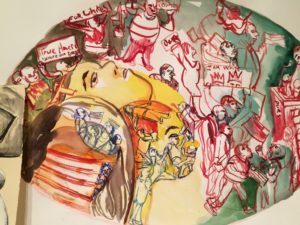 The millions of people who turned out for the world wide Women’s March to protest the new administration and make a plan of action was a spectacular and inspiring event. I joined my two brothers for the huge rally on the Boston Commons, with its history as the birthplace of the American Revolution, center of the abolition movement, point of departure for Freedom Riders, and an ideal place for hundreds of thousands of people to gather.
The millions of people who turned out for the world wide Women’s March to protest the new administration and make a plan of action was a spectacular and inspiring event. I joined my two brothers for the huge rally on the Boston Commons, with its history as the birthplace of the American Revolution, center of the abolition movement, point of departure for Freedom Riders, and an ideal place for hundreds of thousands of people to gather.
But the inspiration and urgency of the speeches by politicians, Native Americans, Muslim activists, union workers, Planned Parenthood defenders, NAACP, youth with disabilities and LGBTQ, was poignantly underscored by two meetings with Maria de Los Angeles, an extraordinary artist who is among the group of people most vulnerable under the new administration, those youth known as DACA, (Delayed Action for Childhood Arrival I explain it below). See the image at the top of the post, of the young woman surrounded by the anxieties of the situation.
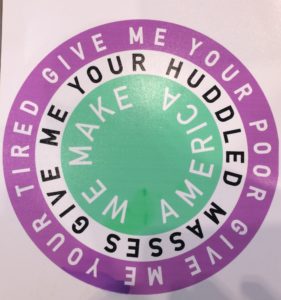
I first met Maria de Los Angeles through “We make America” an informal group of artists making 100 Statues of Liberty in mourning, with tunic, torch and crown for the Women’s March in Washington, D.C. and New York City. The day after the election, she and Joyce Kozloff, (for whom she was working and who has a long history of art activism) called a meeting to decide what to do to build community and respond to the election as artists.
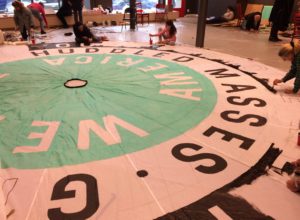
The result was “We Make America”, a title which suggests that we all contribute to what America is today. The verb “make” can also literally refer to contributions of workers, immigrants, and the act of making things. Perfect. The group started small, then ballooned when it was put on Facebook the next day.
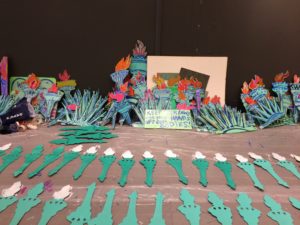
When I went to photograph the making of the props for the Women’s March, Joyce pointed me to Maria as a primary organizer.
Maria told me immediately that she is a one of the thousands of DACA, young people and twenty somethings who came here without papers as children and were given status under Obama to go to school and work legally. They are extremely vulnerable to losing that status any minute under the current administration.
Maria de Los Angeles was born in Mexico and came to California with her parents at the age of 11, growing up in Santa Rosa California. She went to Pratt on a fifty percent scholarship. Since she could not get loans as a DACA, she managed to fundraise the rest of it (these schools are insanely expensive). Then she got a full scholarship to Yale, where the professors encouraged her to question who she was and discover what she wanted to say. She talked about how difficult it was to find her voice in the midst of the fashionable “identity politics” that pigeonholed her as a successor to Frida Kahlo, dismissed her affinity with German Expressionism.
But she asserted herself and succeeded in finding her voice. Apparently there were about ten students of color in her class of 100, and most of them didn’t want to be pigeonholed or talk about race.
Last summer Pratt, where she now teaches, invited her to teach a course in Italy, giving her the opportunity to see the murals of Tintoretto in Venice, as well as the whole sweep of Italian Renaissance Art. The huge floating figures of Chagall in Lincoln Center also inspire her, as well as Siqueiros, the most radical of the Mexican muralists, who successfully paired radical politics with experimental media. I immediately saw her connection to Kathe Kollwitz, as an outspoken radical and a women addressing oppression expressed through dynamic linear drawings.
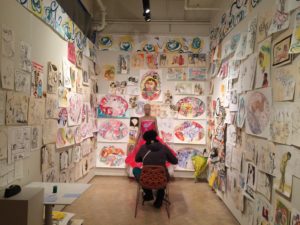
I recently saw an installation of her drawings and watercolors at Museo del Barrio where she is an artist in residence until the end of this week (January 28).
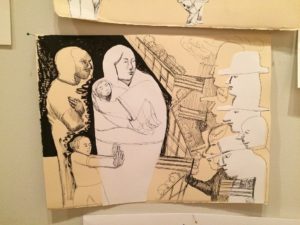
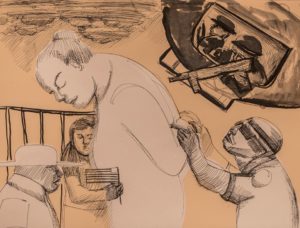
She draws with ink or watercolor on two types of paper, printmaking (which is manila) and drawing paper (which is white). In some works she draws figures on the lighter drawing paper, cuts them out and glues them onto the manila paper on which she also draws. The two tones create a dynamic that reinforces the primary theme of her work, the confrontation between ICE (Immigration and Customs Enforcement) officials and Latinos, the threat of a home raid, a work raid, a traffic stop, leading to detention and deportation, the constant terror of a family being torn apart.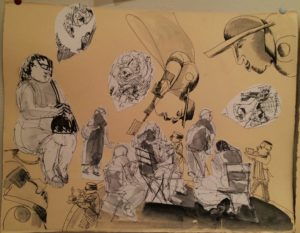
But it is not a simplistic formula. Not all of the white people are cut out with white paper or all the Latinos in manila. That is of course because that is true in real life. In fact some ICE officials are Latinos (as seen in the Alex Rivera film, El Hielo), some Latinos are white skinned (as Maria herself). ( see also Alex Rivera’s other films and projects here)
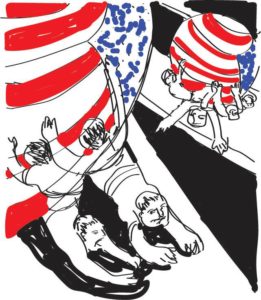
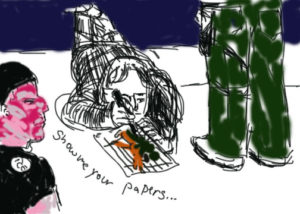
But the two colors of paper create a tension, emphasize the sense of confrontation because of the fear and hostility that is escalating every day.
Sometimes there is also text, tiny words like “My America” “Our America” emerge in bubbles from the mouths of agents, or longer texts written around the edge of the drawing are filled with the racist taunts and the clichés of white people who fear immigrants.
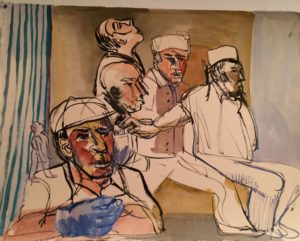
Some of the works are purely drawing, some watercolors, some cartoon like. Some combine watercolor and drawing. Maria de los Angeles breaks through restrictions, and conventions, just as she would like to see the barriers between races break down.
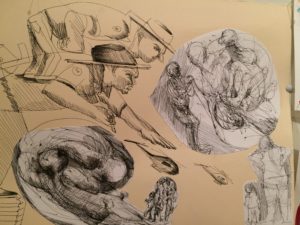
A frequent motif is ICE agents swooping down from the sky on families trying to protect themselves. Families are represented by islands of emotional lines that suggests anguish, terror, and self-protection.
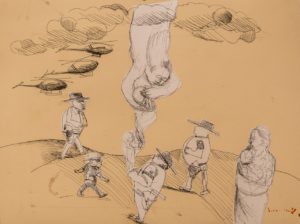
But sometimes salvation itself swoops down from the sky, to rescue someone from the agents on the ground.
Most of the drawings that I saw were created before the election. That means de Los Angeles has been making visible the ongoing tensions in the Latino community for a long time.
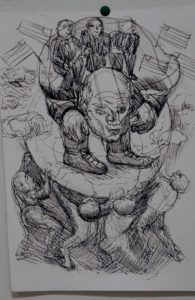
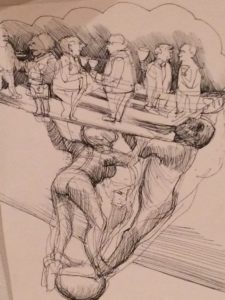
Another theme honors the almost invisible contributions of workers. That format depicts a group of workers, holding up the white world of privilege often precariously. In a You Tube interview she also spoke of all oppressions, she does not limit her activism to only immigration, she referred to the whole range of concerns we have today.
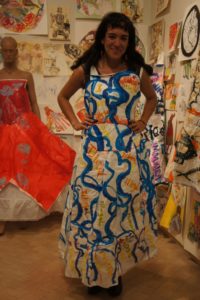
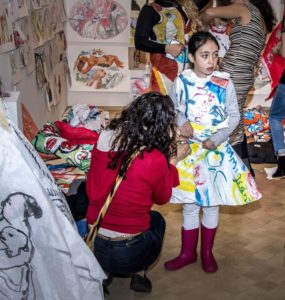
Maria de los Angeles also creates garments. She sews paper together, and paints them with confrontational slogans, such as “illegal” and “undocumented.”, then with friends does interventions, such as recent action at a Trump hotel. She boldly speaks to media about her status, and her fears for her own future and those of so many others.
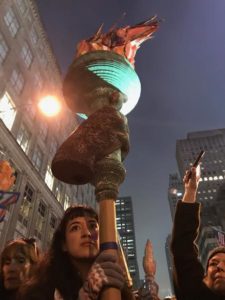
She held up the heavy corrugated cardboard torch of the Statue of Liberty for eight hours during the women’s march in New York City, leading the contingent of “We Make America”.
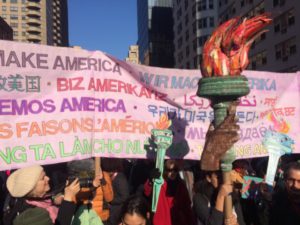
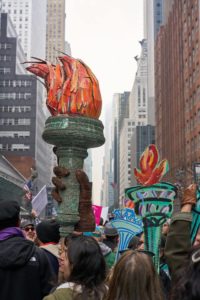
Pay attention to what happens in the next week or so with the Immigration regulations. Protest any reversal of the small reforms, such as DACA, enacted by the Obama administration. As someone who has been following immigration issues for several years, I have been horrified by his huge number of deportations and detentions which includes putting families and children in detention. They were horrendous, but unfortunately the terrible procedures and facilities already in place are now going to get much worse. Research the facts on detention at the excellent Detention Watch Network and Not One More Deportation.
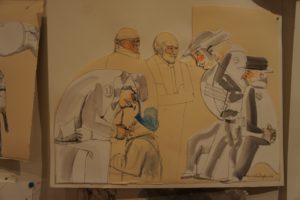
Maria de los Angeles is a courageous person. She has chosen to express the dark fears and nightmares of Latinos in her drawing as well as to publicly speak about her status. I don’t know of any other artist who has done so much work on this subject.
Now she wants to network with other artists, as well as the general public, to encourage them to understand the complexity of the immigration system, the impossibility of being documented as an undocumented person, and the possibilities for art to address these subjects. She sees art as a powerful tool that for her must bridge the huge gap between her background and the “art world.” Her public interventions are one type of bridge. Joining with others is another.
She is hoping that “We Make America” as a collaboration of activist artists will continue to produce art about immigration. The Statue of Liberty is our most public immigration statement, together with its famous poem by Emma Lazarus ( who spent her life fighting anti Semitism and supporting immigration before she died at the age of 28). It is as crucial today as it was when it was created.